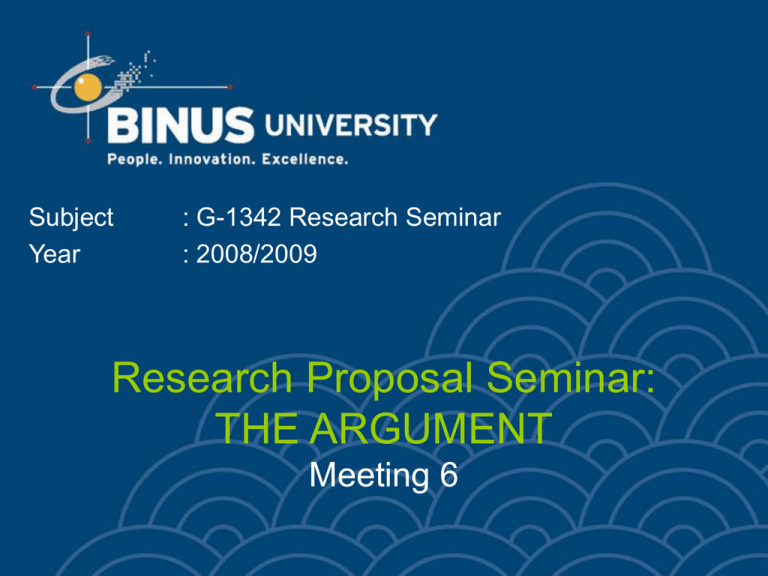Research Proposal Seminar: THE ARGUMENT Meeting 6 Subject
advertisement

Subject Year : G-1342 Research Seminar : 2008/2009 Research Proposal Seminar: THE ARGUMENT Meeting 6 STRUCTURING ARGUMENTS • “A speech has two parts. Necessarily, you state your case, and you prove it” (Aristotle). • An argument, at its simplest level, consists of three simple steps: 1. You make a claim 2. You offer evidence 3. You show how the evidence proves the claim. Bina Nusantara University • The claim is the conclusion of your argument, the statement you want your listener to accept, e.g. “The most important thing you can learn in college is how to learn”. • The evidence is supporting material a presenter/speaker uses to prove a point. Bina Nusantara University TYPES OF ARGUMENT 1. Argument by examples or inductive argument: says that what is true of a few instances is true generally. Key points: • Are the examples true? • Are the examples relevant? • Are the examples sufficient? • Are the examples representative? Bina Nusantara University 2. Argument by analogy: says that what is true in one case is or will be true in another. Key Points: – Are the similarities between the two cases relevant? – Are any of the differences between the two cases relevant? Bina Nusantara University 3. Argument by cause: says that one action or condition caused or will cause another. Key Points: – Does the causal relationship exist? – Could the presumed cause produce the effect? – Could the effect result from other causes? Bina Nusantara University 4. Argument by deduction: says that what is true generally is or will be true in a specific instance. Use the following steps to check the structure and flow of your deductive argument (called syllogism): 1. State your major premise. 2. Say “because” and then state your minor premise. 3. State your conclusion. Bina Nusantara University • Terms: 1. Syllogism: the pattern of a deductive argument, consisting of a major premise, a minor premise, and a conclusion. 2. Major premise: a claim about a general group of people, events, or conditions. 3. Minor premise: a statement placing a person, an event, or a condition into a general class. 4. Conclusion: the deductive argument that what is true of the general class is true of the specific instance. Bina Nusantara University • Key Points: 1. Do the premises relate to each other? 2. Is the major premise true? 3. Is the minor premise true? Bina Nusantara University • 5. Argument by authority: uses testimony from an expert source to prove a speaker’s claim. Key Points: - Is the source an expert? - Is the source unbiased? Bina Nusantara University Useful Terms on Fallacies of Arguments: • Fallacy: a flaw in the logic of an argument. • Hasty Generalization: a fallacy that makes claims from insufficient or unrepresentative examples. • Post Hoe: a chronological fallacy that says that a prior event caused a subsequent event. • Slippery Slope: a fallacy of causation that says that one action inevitably sets a chain of events in motion. • Red Herring: a fallacy that introduces irrelevant issues to deflect attention from the subject under discussion. Bina Nusantara University • Appeal to Tradition: a fallacy that opposes change by arguing that old ways are always superior to new ways. • False Dilemma: a fallacy that confronts listener with two choices when, in reality, more options exist. • Bandwagon: a fallacy that determines truth, goodness, or wisdom by popular opinion. • Ad Hominem: a fallacy that urges listeners to reject an idea because of the allegedly poor character of the person voicing it; name calling. Bina Nusantara University

